Don't wanna be here? Send us removal request.
Text
Steel Strainers in High-Pressure Lab Systems: Key Benefits
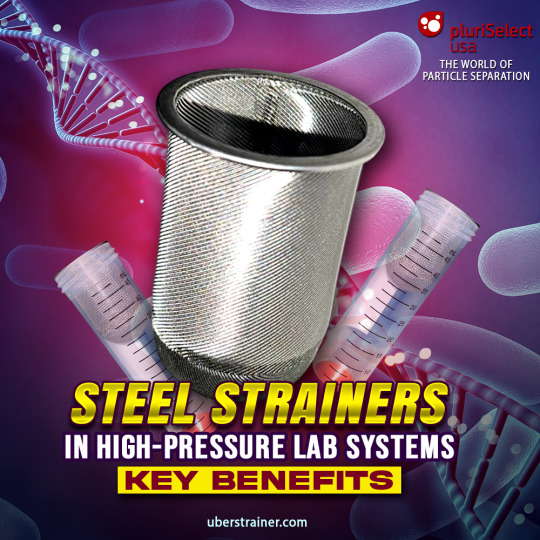
Modern laboratory workflows, especially those involving high-pressure systems, require robust tools that can withstand demanding conditions without compromising performance. Among these tools, Lab Cell Strainer have become critical for filtering, purifying, and preparing samples across disciplines like biotechnology, immunology, and pharmaceutical research. When operations are carried out under elevated pressure or involve aggressive media, traditional plastic strainers may not be sufficient. In such environments, steel strainers offer a more durable and efficient alternative.
Steel strainers are designed to handle continuous pressure, maintain structural integrity, and offer consistent filtration, making them ideal for high-pressure lab systems. This article explores the key advantages of using steel strainers, focusing on their relevance in particle filtration, sample clarity, and consistent cell separation—all within the framework of professional research and industrial processes.
Durability and Performance Under Pressure
In laboratory environments where pressure-driven workflows are necessary—such as perfusion systems, pressurized filtration units, or flow-based particle sorters—plastic or mesh-based cell strainer units may deform, clog, or fail. This is where steel strainers provide a significant advantage.
Made from fine stainless-steel mesh, these strainers can withstand high pressures without collapsing or warping. The mesh remains intact under constant stress, enabling accurate filtration across extended runs. This is particularly beneficial for labs processing dense tissue suspensions, fibrous materials, or viscous liquids that require steady pressure to move through filtration units.
In contrast to plastic or nylon filters, which can absorb fluid or become damaged during autoclaving, steel strainers are heat-resistant and reusable. They can undergo multiple sterilization cycles without degrading, making them cost-effective over time and ideal for maintaining sterility in sensitive environments.
Moreover, the rigid structure of steel strainers minimizes sample loss. Because the mesh holds firm even under pressure, there’s reduced risk of membrane flexing or distortion, which can cause valuable cells to be lost or trapped. For researchers dealing with limited or delicate sample volumes, every cell counts—and a strong, reliable filter makes a difference.
Consistent and Precise Filtration for Cell Separation
When separating cell populations from complex biological mixtures, consistency is key. Even a small change in filtration performance can affect downstream analysis. Steel strainers enable precise cell separation by delivering a uniform and steady flow rate, ensuring that each sample is filtered to the same standard.
This level of control becomes particularly important when preparing samples for flow cytometry, single-cell sequencing, or advanced imaging. Any clumps or debris remaining after filtration can obstruct downstream systems or distort analysis results. Steel strainers effectively remove such particles while preserving the viability and integrity of target cells.
Lab cell strainer products made from stainless steel also come in various mesh sizes tailored for different separation needs. For example, finer meshes can be used to isolate lymphocytes or stem cells, while broader meshes are suitable for removing connective tissue fragments or aggregates from enzymatically digested samples.
Another important benefit is the reduced risk of contamination. Steel strainers are non-absorbent and chemically inert, which helps prevent interaction with reagents or cells. This ensures a cleaner separation process and reduces interference in assays or cultures.
Because steel strainers are built for repetitive use, they offer consistent pore integrity over time. Unlike plastic filters that may lose their shape, a steel filter provides the same level of accuracy with every use—crucial when running parallel samples or maintaining standardized protocols.
Compatibility with Particle Separation Techniques
High-pressure systems are often part of complex particle separation techniques, where multiple processes are used to refine a sample before final analysis. These might include centrifugation, pressure-based filtration, microfluidics, or chromatography systems. Steel strainers integrate seamlessly into these techniques by serving as a stable, pressure-resistant pre-filtration step.
In workflows where centrifuged samples need further purification, a steel lab cell strainer ensures only single cells or small particles are carried forward. This reduces variability and improves reproducibility in experiments, especially those that require statistical accuracy over a large number of samples.
For example, before samples undergo gradient separation or column-based sorting, they must be free of aggregates or large particles. Steel strainers can manage this pre-processing quickly without blocking or tearing. Their rigid mesh construction prevents shifting during fluid pressure changes, which can otherwise create inconsistencies in filtered volume or output quality.
Steel strainers are also ideal for maintaining flow in microfluidic systems, where even slight clogs can disrupt chip-based particle sorting. By placing a steel cell strainer upstream of such systems, users can maintain stable input flow, protecting delicate instruments and extending their operational life.
Because many of these techniques require precision and reliability, especially in clinical or pharmaceutical settings, the structural resilience and uniform filtration of steel strainers ensure smooth integration without introducing variability.
Supporting Cascade Straining in High-Pressure Systems
Cascade straining involves passing samples through a series of strainers with progressively smaller pore sizes. This step-by-step approach helps remove debris and isolate cells based on size. In high-pressure workflows, where sample processing needs to be fast, accurate, and efficient, steel strainers are especially useful for supporting cascade straining.
The strength of steel mesh allows multiple strainers to be used in sequence without any risk of collapse or mesh distortion. This enables precise size-based separation, starting with a broader mesh to remove larger particles and gradually moving to finer meshes for specific cell targets.
For example, a sample can first pass through a 150 μm mesh to eliminate tissue debris, followed by 100 μm, then 70 μm, and finally a 40 μm filter to achieve a clean single-cell suspension. Each stage of this cascade benefits from the pressure-tolerant design of steel strainers, as samples can be pushed through efficiently without requiring vacuum assistance or dilution.
This method is particularly helpful in isolating heterogeneous cell populations, such as those from tumors, inflamed tissues, or bone marrow aspirates. As the sample becomes more refined with each step, the steel strainers ensure high throughput without clogging, sample loss, or contamination.
Additionally, steel strainers used in cascade workflows can be cleaned, sterilized, and reused, which makes them a cost-effective choice for laboratories with heavy workloads or high-throughput requirements. Their ability to maintain mesh integrity over repeated use means labs can rely on consistent performance even after dozens of runs.
Conclusion
In high-pressure laboratory systems, equipment reliability is essential. For filtration steps in particular, using the right strainer can improve efficiency, sample quality, and the overall success of experimental outcomes. Steel strainers provide the structural strength, precision, and reusability that researchers need when working in demanding conditions.
As a trusted member of the Lab Cell Strainers family, steel strainers are especially suited for pressure-driven workflows. Their ability to maintain consistent filtration under stress, support accurate cell separation, and integrate into advanced particle separation techniques makes them a valuable asset in modern research and production labs. Whether used in cascade straining, upstream sample preparation, or final filtration before analysis, steel strainers offer performance that plastic filters simply can't match.
For research labs and biotech companies seeking dependable filtration tools, adopting steel strainers is a smart move that supports both precision and productivity.
#uberstrainer#medical#cellsepration#antibody cell separation#cell separation technology#particle separation techniques#particle filtration#40 um cell strainer#cell enrichment techniques
1 note
·
View note
Text
Overhead Rotation in SnapCap Strainers: Why It Improves Extraction Efficiency
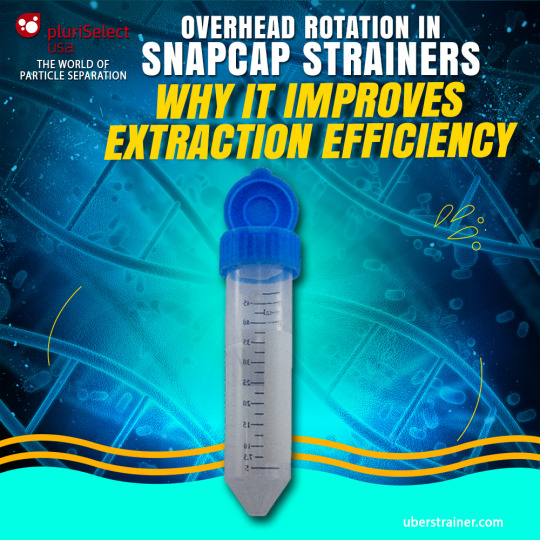
In laboratory settings, the efficiency of sample preparation directly influences the quality of downstream analyses. Among the tools employed for this purpose, Lab Cell Strainers are pivotal in isolating cells from complex mixtures. The introduction of overhead rotation in SnapCap strainers has marked a significant advancement, enhancing extraction efficiency and consistency.
Understanding Overhead Rotation in SnapCap Strainers
Overhead rotation refers to the mechanism where the strainer's cap rotates above the filtration chamber. This motion ensures uniform distribution of the sample across the mesh, promoting consistent filtration. Unlike static strainers, the rotating action minimizes clogging and facilitates the passage of cells through the mesh.
The SnapCap Steel Extraction Strainer exemplifies this innovation. Its design incorporates a durable metal mesh within a rotating cap, enhancing chemical compatibility and ensuring long-term reliability. The airtight elastomer sealing further prevents leaks and contamination, making it suitable for sensitive applications.
Advantages of Overhead Rotation in Lab Cell Strainers
1. Enhanced Filtration Efficiency
The rotating cap ensures that the sample continuously moves over the mesh surface, reducing the likelihood of clogging and promoting efficient filtration.
2. Improved Sample Integrity
Gentle rotation minimizes shear forces, preserving the viability and functionality of delicate cells during the filtration process.
3. Time-Saving
Continuous movement accelerates the filtration process, allowing for quicker sample preparation without compromising quality.
4. Versatility
SnapCap strainers are compatible with various mesh sizes, including 70 µm, 40 µm, and 100 µm, catering to diverse cell types and applications.
Integration with Particle Separation Techniques
Overhead rotation in SnapCap strainers complements various particle separation techniques. By ensuring uniform sample distribution, it enhances the effectiveness of methods like density gradient centrifugation and magnetic-activated cell sorting. The consistent movement prevents cell aggregation, facilitating more precise separations.
Incorporating different mesh sizes, such as the 70 µm cell strainer, 40 µm cell strainer, and cell strainer 100 µm, allows for tailored filtration based on specific requirements. This adaptability is crucial for applications ranging from stem cell research to immunology.
Applications in Cell Separation
In cell separation workflows, precision and consistency are essential. The process involves isolating specific cell types from a complex mixture—often consisting of blood, tissue digests, or bone marrow—to obtain a purified population for downstream applications such as flow cytometry, culture, or molecular profiling. SnapCap strainers equipped with overhead rotation have brought a new level of refinement to this process.
One of the main challenges in cell separation is avoiding sample loss and maintaining cell viability. Conventional static filtration methods often result in clogging, uneven sample flow, and high shear stress, which can damage delicate cells or skew the recovery of certain populations. The overhead rotation mechanism in SnapCap strainers addresses these limitations directly. By rotating the cap above the mesh, the sample is continuously and evenly distributed across the entire filtration surface. This prevents localized build-up and encourages cells to pass through the mesh smoothly, preserving their natural structure and function.
This feature is particularly important when working with fragile or rare cell types. For example, during the isolation of immune cells from tissue samples, overhead rotation ensures gentle handling and minimizes the mechanical forces that could trigger cell activation or lysis. This results in a cleaner, more representative population for analysis.
SnapCap strainers also support the use of different mesh pore sizes—like 70 µm, 40 µm, and 100 µm—making them suitable for cascade straining. In a typical workflow, a 100 µm strainer might first be used to eliminate debris and aggregates, followed by 70 µm and 40 µm strainers to progressively refine the cell suspension. The rotating cap maintains efficient flow during this sequential filtering, reducing the chance of blockage at any stage.
For researchers conducting flow cytometry, overhead rotation ensures a more homogenous single-cell suspension with fewer clumps, allowing for accurate gating and better data quality. Similarly, in cell culture applications, improved filtration reduces the risk of contamination and ensures uniform seeding of healthy cells.
Overall, SnapCap strainers with overhead rotation offer a practical and reliable solution for enhancing cell separation workflows, improving both the quality and consistency of outcomes in laboratory research.
Integration of Overhead Rotation in High-Throughput Laboratory Workflows
In modern laboratories, the demand for high-throughput processing necessitates equipment that can handle large sample volumes efficiently while maintaining sample integrity. Overhead rotation in SnapCap strainers addresses this need by facilitating continuous and uniform filtration, which is crucial for processing multiple samples simultaneously.
The rotating mechanism ensures that each sample experiences consistent shear forces, reducing variability between samples. This uniformity is particularly beneficial in applications such as flow cytometry, where consistent sample preparation is critical for accurate results. Moreover, the design minimizes manual intervention, allowing for automation and integration into robotic systems, thereby increasing throughput and reducing the potential for human error.
Additionally, the compatibility of SnapCap strainers with various mesh sizes, including 70 µm, 40 µm, and 100 µm, allows for customization based on specific sample requirements. This adaptability ensures that laboratories can process a wide range of samples, from large cell aggregates to single-cell suspensions, without compromising efficiency or sample quality.
Furthermore, the robust construction of these strainers ensures durability and longevity, making them a cost-effective solution for laboratories that require reliable equipment for high-throughput applications. The ease of cleaning and sterilization also contributes to their suitability for repeated use in rigorous laboratory environments.
Considerations for Implementing Overhead Rotation in Specialized Applications
While the advantages of overhead rotation in SnapCap strainers are evident, certain considerations must be addressed when implementing this technology in specialized applications. For instance, in clinical laboratories where sample integrity is paramount, it's essential to ensure that the rotating mechanism does not introduce contamination or compromise sterility. Therefore, selecting strainers with airtight seals and materials compatible with sterilization processes is crucial.
In research settings focusing on delicate cell types, such as stem cells or primary neurons, the gentle handling provided by overhead rotation is beneficial. However, it's important to calibrate the rotation speed appropriately to prevent mechanical stress that could affect cell viability. Conducting preliminary tests to determine optimal operating conditions can help in achieving the desired balance between efficient filtration and cell preservation.
Moreover, when integrating overhead rotation strainers into existing workflows, compatibility with current equipment and protocols should be evaluated. Ensuring that the strainers fit seamlessly into centrifuge rotors or automated systems will facilitate a smooth transition and maximize the benefits of the technology.
Lastly, training laboratory personnel on the proper use and maintenance of overhead rotation strainers is essential. Understanding the operational nuances and maintenance requirements will help in prolonging the lifespan of the equipment and maintaining consistent performance across applications.
Conclusion
The integration of overhead rotation in SnapCap strainers represents a significant advancement in laboratory filtration techniques. By enhancing efficiency, preserving sample integrity, and offering versatility, these strainers address the evolving needs of modern laboratories. For researchers and businesses seeking reliable and efficient sample preparation tools, Lab Cell Strainers with overhead rotation offer a compelling solution.
#uberstrainer#medical#cellsepration#antibody cell separation#cell separation technology#particle separation techniques#particle filtration#40 um cell strainer#cell enrichment techniques
1 note
·
View note
Text
Particle Recovery Made Easy with In-Line Strainer Recovery Reservoirs

Sample filtration is an essential part of many laboratory protocols, from cell culture to clinical diagnostics and pharmaceutical development. One of the tools that has gained increasing attention in recent years is the in-line strainer with recovery reservoirs. These compact, efficient devices are transforming how researchers approach particle separation techniques and sample recovery. While Lab Cell Strainers have traditionally been associated with gravity-driven or manual filtration, in-line straining introduces a more integrated approach—bringing precision and convenience into particle recovery workflows.
This article explores how in-line strainer recovery reservoirs simplify particle collection and why they represent a major step forward for labs looking to improve sample quality, consistency, and operational efficiency.
The Role of Lab Cell Strainers in Modern Labs
In biological and clinical research, lab cell strainers are indispensable for preparing single-cell suspensions, removing debris, and ensuring consistent downstream processing. Whether you're filtering dissociated tissues, isolating immune cells, or separating particles from viscous samples, the choice of strainer can significantly affect sample yield and purity.
In traditional setups, strainers such as 70 µm cell strainers, 40 µm cell strainers, and 100 µm cell strainers are manually placed on top of conical tubes to allow gravity or gentle pipetting to carry the sample through. While effective, these setups require active monitoring, can lose precious material during transfer, and don’t always scale well in workflows demanding multiple filtration steps or continuous processing.
This is where in-line strainer recovery reservoirs come in, offering a more seamless and controlled alternative.
What Are In-Line Strainer Recovery Reservoirs?
In-line strainer recovery reservoirs are closed, sterile units designed to fit directly into tubing systems or liquid circuits. They combine mesh filters of specific pore sizes—like cell strainer 100 µm or 40 µm cell strainer—with collection compartments that allow filtered particles to be easily recovered for further use.
Unlike conventional filter units, in-line strainers offer continuous flow compatibility, often using pressure or peristaltic pumps. The attached recovery reservoirs act as a collection zone, preventing loss of valuable material during the separation process. This is particularly helpful in workflows that involve sequential steps or fluid transfers between instruments.
Why In-Line Strainers Simplify Particle Recovery
One of the most time-consuming tasks in filtration protocols is transferring filtered material from one container to another. During these steps, particles may adhere to surfaces, disperse in solution, or become lost in transfer pipettes. In-line strainer reservoirs address this by trapping and collecting the desired particles immediately after filtration, right where they are separated.
This makes it easier for labs to:
Collect high-value particles or cells for downstream use
Minimize material loss across multiple filtration steps
Maintain sterile, closed-loop systems in sensitive workflows
Whether used for cell separation, bead recovery, or particle concentration, in-line reservoirs reduce sample handling and increase yield.
Supporting Scalable Particle Separation Techniques
As labs move toward higher throughput and scalable processes, manual steps become bottlenecks. Traditional cell strainer models work well for small-scale procedures but aren’t optimized for continuous or large-volume processes.
In-line strainers provide an answer. Integrated into tubing systems, they can operate under pressure and allow for the continuous processing of liters of fluid. The modular design makes it easy to swap mesh sizes (such as switching from a 70 µm cell strainer to a 40 µm cell strainer) depending on the particle profile required.
In workflows like cascade straining—where multiple mesh sizes are used in sequence—this becomes especially valuable. Recovery reservoirs attached to each stage capture particles separated at different steps, helping researchers build cleaner and more accurate profiles of their samples.
Application Scenarios in Particle Recovery
In-line strainer reservoirs are useful in a range of research and industrial settings. Some common applications include:
1. Tissue Dissociation and Cell Isolation
In labs dissociating complex tissues like lung, liver, or spleen, pre-filtering digests through a cell strainer 100 µm helps remove clumps. Follow-up steps often involve narrower mesh sizes like 70 µm or 40 µm to isolate finer cells. Recovery reservoirs ensure that cells caught at each stage are preserved and accessible.
2. Microbead or Bead-Based Separation
Magnetic and polymeric beads are widely used in cell separation and molecule capture techniques. In-line strainers allow labs to easily recover these beads post-filtration using the recovery compartment—no centrifugation or magnetic racks required during the straining step.
3. Viral Vector and Exosome Filtration
Filtration of viral particles or extracellular vesicles demands precise control over pore size and sample handling. In-line strainers provide both, along with minimal dead volume. Recovery reservoirs ensure small particles are not lost in transfer or retained in filter housings.
4. Clarifying Culture Media and Buffers
When harvesting large-scale culture media for downstream purification, it’s essential to remove debris and aggregates. An in-line lab cell strainer allows for pre-clarification, and recovery compartments can be used to inspect or reuse collected material.
Supporting Quality and Sterility
Another major advantage of in-line strainers is their contribution to sterility. Designed to fit into closed-loop systems, these devices limit exposure to air and contamination. This is particularly critical in clinical, GMP, or BSL-certified environments where sample integrity and contamination prevention are non-negotiable.
Recovery reservoirs, being part of the same closed unit, further reduce the risk of sample exposure. They can be pre-sterilized and individually packed, ensuring that labs don't need to autoclave or disinfect before use.
Integration into Custom Lab Setups
One of the standout features of in-line strainers with reservoirs is their flexibility. They can be added to any tubing system, including peristaltic pump loops, bioreactor circuits, and multi-step sample prep stations. Mesh size is customizable, with options matching standard formats like 70 µm cell strainer, 40 µm cell strainer, or finer.
Because they can be used in cascade straining, labs benefit from step-wise separation in a single pipeline, collecting particles at each level in dedicated reservoirs. This helps researchers conduct quality checks, analyze sub-populations, or recover rare particles without interrupting the flow.
Reducing Plastic Waste and Promoting Reusability
While many filtration tools are disposable, in-line strainers with reservoirs often support reuse, depending on the application. Some models are autoclavable or compatible with chemical disinfection, making them a more sustainable alternative in long-term use.
By reducing the number of pipette tips, transfer tubes, and disposable containers used during filtration, these devices also help labs cut down on plastic waste and operational costs.
Conclusion
For researchers looking to streamline workflows, minimize sample loss, and improve recovery rates, in-line strainer recovery reservoirs present a smart, efficient solution. These tools integrate seamlessly into both manual and automated systems, offering control over flow, filtration, and collection—all in one closed unit. In comparison to traditional setups, they provide better support for cell separation, tissue processing, and particle-based workflows.
If you're investing in reliable, scalable lab cell strainers, it's time to explore the benefits of in-line strainers with built-in recovery reservoirs. They simplify particle recovery and bring consistency to modern lab processes where every drop counts.
#uberstrainer#medical#cellsepration#cell separation technology#antibody cell separation#particle separation techniques#particle filtration#40 um cell strainer#cell enrichment techniques
0 notes
Text
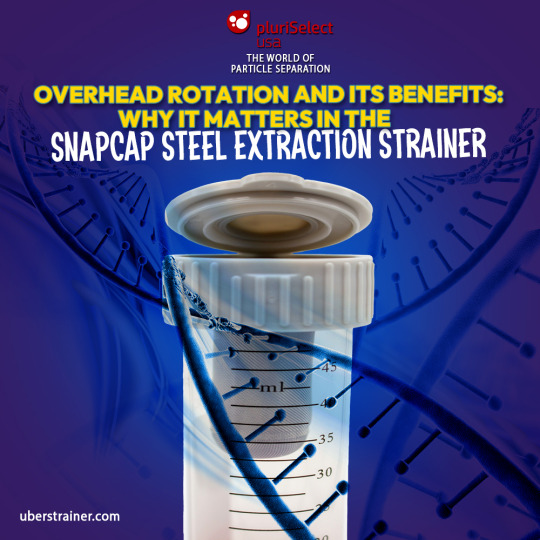
Overhead Rotation and Its Benefits: Why It Matters in the SnapCap Steel Extraction Strainer
In many lab-based processes, the tools used can significantly affect the quality, accuracy, and efficiency of the outcome. Whether preparing a sample for analysis or isolating specific particles from a mixture, the right equipment can streamline workflow and reduce the risk of contamination or sample loss. Among these essential tools, the best Lab Cell Strainers play a major role in optimizing sample preparation and filtration. However, when it comes to chemical extraction and particle separation techniques from solids, tools like the SnapCap Steel Extraction Strainer stand out due to their unique design features—especially the ability for overhead rotation.
This feature is not just about convenience. Overhead rotation directly contributes to a more effective extraction process, ensures even contact between the solvent and the solid, and enhances the reliability of the results. In this blog, we’ll explore how the SnapCap Steel Extraction Strainer functions and why overhead rotation is a key benefit worth considering for researchers and labs alike.
Understanding the SnapCap Steel Extraction Strainer
Before diving into the advantages of overhead rotation, it’s helpful to understand how the SnapCap Steel Extraction Strainer is designed. The device features a metal strainer integrated into a snap cap, forming a compact and practical tool for extracting chemicals or particles from solid matter. It includes a 9 cm³ internal volume, which allows for a decent amount of material to be processed at once.
What makes this product particularly effective is its airtight elastomer sealing, which prevents leaks or exposure to air during processing. This is especially important when working with volatile solvents or sensitive materials that could degrade in open environments.
The Role of Overhead Rotation
The SnapCap’s ability to be rotated overhead brings several advantages to the table. It is more than just a mechanical feature—it’s a functional aspect that impacts how well the strainer performs during extraction processes.
1. Enhanced Mixing for Efficient Extraction
One of the biggest benefits of overhead rotation is improved mixing. When a strainer is rotated overhead, the contents inside are agitated continuously, ensuring that the solvent makes full contact with the solid particles. This increases the efficiency of chemical extraction and helps reduce the time needed to obtain a usable sample.
In a static setup, where the solvent simply sits around the solid, extraction can be uneven or incomplete. Overhead rotation removes this limitation, allowing the solvent to access more surface area consistently.
2. Improved Contact Between Solids and Solvents
Consistent rotation ensures that the solid material inside the SnapCap Steel Extraction Strainer is always exposed to fresh solvent. This continuous interaction prevents layering or compaction of solids at the bottom, which can block effective penetration.
The more uniform the contact, the better the chances of complete extraction. For researchers working with valuable or limited materials, this ensures that no sample goes to waste and the most is made from every run.
3. Better Results in Less Time
In most laboratory environments, time is a critical factor. Faster extraction means quicker analysis, testing, or production. With the SnapCap’s ability to rotate overhead, labs can speed up the filtration process without sacrificing quality or yield.
Instead of waiting for passive extraction methods to complete, overhead rotation accelerates the process, improving productivity across the board.
4. Consistent Sample Quality
Whether you're using a cell strainer for biological samples or a chemical strainer like the SnapCap, consistency is key. Overhead rotation reduces variability between samples by ensuring that each extraction is carried out under the same dynamic conditions.
This is particularly important in settings where precise measurements or sensitive results are required. The more predictable the method, the more reliable the data.
5. Less Manual Intervention
Manual shaking or tilting of tubes is a common workaround in labs that don’t use rotating devices. This method is not only inconsistent but also labor-intensive and prone to human error. The overhead rotation feature of the SnapCap Steel Extraction Strainer automates this process, reducing the burden on lab personnel while improving outcomes.
With reduced handling, there's also less risk of contamination or sample disturbance—especially useful in sterile environments or when processing hazardous materials.
How It Compares to the Best Lab Cell Strainers
Although the SnapCap is designed for chemical and solid particle extraction, its principles overlap with those of the best Lab Cell Strainers. Both aim to provide clean, usable samples by separating unwanted particles from the material of interest.
Where lab cell strainers focus more on biological samples and cell separation technology, the SnapCap Steel Extraction Strainer brings a similar level of efficiency and reliability to chemical processes. Researchers who appreciate the benefits of a good lab cell strainer will recognize the value of overhead rotation in enhancing extraction methods.
Applications in Research and Industry
The SnapCap Steel Extraction Strainer isn’t just for routine lab work. Its design and functionality make it suitable for a range of applications:
Pharmaceutical research: For extracting active ingredients from solid compounds
Environmental testing: To isolate particles from soil or sediment samples
Material science: For solvent extraction from composite materials
Food testing: When analyzing extracts from grains, seeds, or solid foods
In each of these fields, overhead rotation improves repeatability and accuracy, which are essential for quality control and research integrity.
Integration into Existing Workflows
One concern for any lab introducing new equipment is compatibility. Fortunately, the SnapCap Steel Extraction Strainer fits easily into existing lab protocols without the need for significant changes. Its compact design and overhead rotation feature can be combined with standard rotation devices or custom setups, depending on lab requirements.
Moreover, just as the best Lab Cell Strainers are valued for their ease of use and flexibility, the SnapCap offers similar user-friendly features that make it an easy addition to most research settings.
How Overhead Rotation Adds Long-Term Value
Using overhead rotation isn’t just about improving current experiments. Over time, this method can lead to:
Reduced material costs: Better extraction means less waste.
Higher throughput: More samples processed in less time.
Improved data accuracy: Uniform conditions produce consistent results.
Safer lab environments: Less manual handling minimizes risk.
These benefits can directly impact operational costs and research quality, making the SnapCap Steel Extraction Strainer a cost-effective investment for many labs.
Conclusion
The SnapCap Steel Extraction Strainer is a valuable addition to laboratories looking for efficient and reliable chemical extraction tools. Its overhead rotation capability offers a clear advantage by improving mixing, reducing extraction time, and increasing sample consistency. For researchers already familiar with the reliability of the best Lab Cell Strainers, the SnapCap offers the same level of performance in solid-to-liquid extraction processes.
Incorporating this device into your lab's workflow can elevate your extraction procedures while maintaining the quality and precision your work demands. Whether you're in pharmaceuticals, environmental science, or materials testing, the SnapCap Steel Extraction Strainer is designed to meet modern lab needs with dependable results.
#uberstrainer#cell separation technology#particle separation techniques#particle filtration#40 um cell strainer#cell enrichment techniques#antibody cell separation
0 notes
Text
How the SnapCap Steel Extraction Strainer Ensures Airtight and Reliable Chemical Extraction
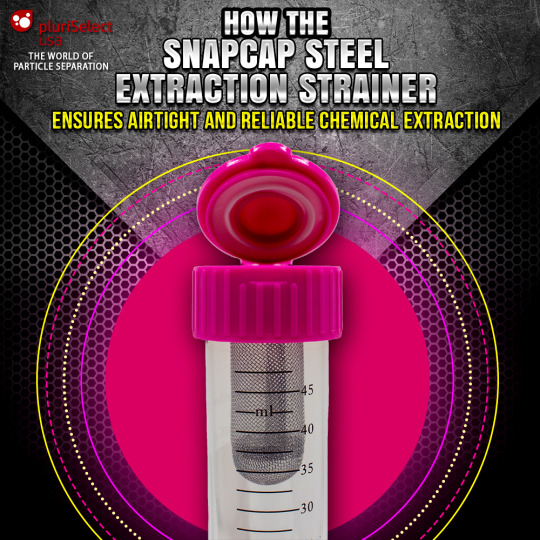
Achieving precise and contamination-free chemical extraction is essential in laboratory research and industrial applications. Choosing the best Lab Cell Strainers ensures efficient separation while maintaining airtight conditions. The SnapCap Steel Extraction Strainer is designed to provide a secure seal, prevent leaks, and improve extraction reliability. Its robust construction and compatibility with various laboratory processes make it a valuable tool for researchers and industries focused on precision extraction.
Key Features of the SnapCap Steel Extraction Strainer
1. Airtight Sealing for Maximum Efficiency
The SnapCap design ensures a completely sealed environment, reducing the risk of evaporation and contamination.
This feature is particularly beneficial for applications requiring precise chemical concentration control.
The airtight seal allows for consistent filtration without compromising sample integrity.
2. Durable Steel Construction for Long-Term Use
Unlike plastic alternatives, the steel build enhances durability and resistance to chemical exposure.
The material prevents deformation, ensuring long-term reliability for laboratory and industrial processes.
It maintains filtration efficiency even under high-pressure conditions.
3. Optimized for Cell Filtration and Separation
The strainer supports various cell separation technology applications by enabling efficient particle retention.
It is suitable for filtering biological samples, ensuring high recovery rates.
Researchers working with sensitive cell cultures benefit from its contamination-resistant design.
4. Compatible with Multiple Mesh Sizes
The SnapCap Steel Extraction Strainer is available in different mesh sizes, including cell strainer 40 um, cell strainer 70 um, and cell strainer 100 um.
A 40 um cell strainer is ideal for fine particle separation, while a 70 um cell strainer is better suited for medium-sized particles.
The 100 um strainer is used for larger particle filtration, ensuring proper separation without clogging.
5. Efficient Use in Strainer Cascade Systems
The strainer can be incorporated into a strainer cascade, allowing multi-stage filtration for enhanced separation accuracy.
This method ensures that different particle sizes are filtered step by step, improving sample purity.
A cascade setup minimizes sample loss while maximizing extraction efficiency.
6. Supports Cell Enrichment and Particle Separation Techniques
The SnapCap Steel Extraction Strainer is useful for cell enrichment techniques, enabling the isolation of specific cell populations.
It enhances particle separation techniques by efficiently filtering out unwanted particles.
This precision ensures high-quality sample preparation for research and industrial use.
Why the SnapCap Steel Extraction Strainer Stands Out
The SnapCap Steel Extraction Strainer offers a combination of airtight sealing, durability, and compatibility with multiple lab cell strainer applications. Whether used for cell separation technology, particle separation techniques, or cell enrichment techniques, it provides reliable results with minimal sample loss.
For researchers and businesses looking to optimize their filtration process, this tool is one of the best Lab Cell Strainers, ensuring secure and efficient chemical extraction for a wide range of applications.
#uberstrainer#medical#cellsepration#antibody cell separation#cell separation technology#particle separation techniques#particle filtration#40 um cell strainer#cell enrichment techniques
1 note
·
View note
Text
Mini Strainer vs. Traditional Filtration: Which One Suits Your Lab Needs?

Choosing the right filtration method is essential for laboratory work, especially when handling small sample volumes. While traditional filtration techniques have been widely used, newer tools like the Mini Strainer offer a more efficient and precise alternative. For researchers looking for the best lab cell strainers, understanding the differences between these two methods can help in making the right decision.
Understanding Mini Strainer and Traditional Filtration
Mini Strainer: A Modern Filtration Tool
The Mini Strainer is a compact cell strainer designed for small sample volumes. It fits a variety of tubes and well plates, making it a versatile choice for laboratories. Available in multiple mesh sizes ranging from 5 µm to 200 µm, it ensures fine filtration without excessive sample loss.
Key features include:
Optimized for Small Samples: Ideal for working with limited material.
Wide Compatibility: Fits tubes from 1.5 ml to 15 ml and well plates.
Single-Use and Sterile: Reduces contamination risk.
Precise Filtration: Helps in cell separation technology and flow cytometry.
Traditional Filtration Methods
Conventional filtration systems rely on paper filters, membrane filters, or centrifugation techniques. These methods have been used for years but come with limitations, particularly for delicate biological samples.
Common types of traditional filtration include:
Membrane Filtration: Often used for microbiological and chemical filtration.
Centrifugation: Separates particles based on density but may require additional steps.
Paper Filtration: A simple technique for larger particles but lacks precision for lab cell strainer applications.
Comparing Mini Strainer and Traditional Filtration
1. Efficiency in Sample Handling
The Mini Strainer is designed for small sample volumes, minimizing waste and reducing handling errors. Traditional filtration methods, such as membrane or paper filters, often require more material and additional processing steps.
2. Precision in Filtration
For applications like cell separation technology, the Mini Strainer offers a more targeted approach with specific mesh sizes. Traditional filters may not provide the same level of control, leading to inconsistent results.
3. Contamination Risk
Using pre-sterilized Mini Strainers lowers the risk of sample contamination. In contrast, traditional filtration often involves reusable components, which require thorough cleaning and sterilization.
4. Compatibility with Strainer Cascade Systems
One major advantage of the Mini Strainer is its ability to integrate with a strainer cascade setup. This allows researchers to filter samples through multiple mesh sizes in sequence, improving sample purity. Traditional methods may require multiple filtration steps, increasing processing time.
5. Versatility in Applications
The Mini Strainer is widely used in:
Flow cytometry sample preparation
Removal of cell clusters and debris
Blood sample processing
Magnetic and fluorescent cell labeling
Traditional methods are useful for broader filtration needs but may not be as effective for lab cell strainer applications that require high precision.
Which One is Right for Your Lab?
For researchers working with small volumes, delicate cell cultures, or requiring precise separation, the Mini Strainer is the better choice. It offers improved efficiency, reduced contamination risk, and compatibility with advanced filtration techniques like strainer cascade systems. Traditional filtration remains relevant for general applications but may not provide the same level of precision.
Conclusion
Selecting the right filtration method depends on the specific needs of your lab. If accuracy, efficiency, and sample purity are priorities, the best lab cell strainers, like the Mini Strainer, provide a modern solution that outperforms traditional filtration methods.
0 notes
Text
Mini Strainer: The Perfect Solution for Small Sample Filtration
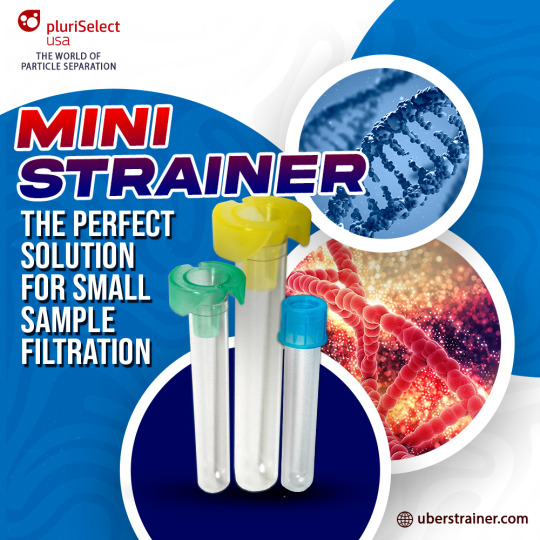
In laboratory work, handling small sample volumes requires precision and efficiency. A reliable filtration tool ensures that researchers can separate particles effectively without losing valuable material. The best lab cell strainers are designed to optimize these processes, and the Mini Strainer is a standout choice. With its ability to fit various tubes and well plates, it simplifies sample preparation while maintaining high filtration accuracy.
What Makes the Mini Strainer Unique?
The Mini Strainer is a compact, pre-sterilized sieving device designed for small sample volumes. It fits securely onto different laboratory tubes, including 1.5 ml reaction tubes, 15 ml conical centrifuge tubes, FACS™ tubes, Cryo vials, and 24/48 well plates. This adaptability makes it a valuable tool across multiple research applications.
Available in seven pore sizes ranging from 5 µm to 200 µm, it allows for precise filtration based on specific sample requirements. The 1 ml reservoir ensures controlled flow, reducing the risk of sample loss.
Applications of the Mini Strainer
The Mini Strainer plays a crucial role in many laboratory procedures, particularly in cell separation technology. Some of its primary uses include:
Cell Suspension Preparation: The strainer efficiently removes cell clusters and aggregates, ensuring a uniform single-cell suspension for analysis.
Flow Cytometry Sample Preparation: It helps in refining samples before fluorescent or magnetic cell labeling, improving experimental accuracy.
Blood Sample Processing: The device effectively eliminates large particles and coagulums, making blood samples suitable for downstream applications.
General Particle Filtration: It can be used for removing unwanted particles from a variety of liquid samples, ensuring purity and consistency.
How the Mini Strainer Enhances Lab Efficiency
Using a lab cell strainer like the Mini Strainer improves research workflows by offering:
Optimized Handling: The built-in gripping surface ensures easy and secure placement, minimizing the risk of spills or contamination.
Sterile and Ready-to-Use Design: The pre-sterilized packaging allows immediate use, reducing preparation time.
Replaceable Components: Researchers can swap out strainer caps and pre-separation filters, making the device cost-effective and adaptable.
Choosing the Right Pore Size
Selecting the appropriate pore size is essential for achieving precise results. The best lab cell strainers offer multiple options, and the Mini Strainer provides flexibility with pore sizes ranging from 5 µm to 200 µm. This variety allows researchers to customize their filtration process based on the specific needs of their experiment.
For instance:
5 µm - 20 µm: Ideal for fine filtration, removing small debris and unwanted particles.
40 µm - 70 µm: Commonly used for cell separation technology, ensuring smooth sample preparation.
100 µm - 200 µm: Suitable for removing larger cell aggregates and unwanted particulates from samples.
The Importance of Reliable Filtration in Research
Accurate filtration is critical for obtaining high-quality experimental results. A cell strainer that provides consistent and efficient sample preparation helps laboratories maintain reproducibility in their research. The Mini Strainer offers a cost-effective, convenient, and high-performance solution for small-volume filtration tasks.
With its compatibility across various lab equipment and its efficiency in filtering different sample types, the best lab cell strainers like the Mini Strainer make a significant impact on daily laboratory operations. Whether for flow cytometry, cell suspensions, or blood sample preparation, this device ensures researchers can work with precision and confidence.
0 notes
Text
Is Your Lab Losing Time on Complex Cell Isolation? Switch to pluriSpin
Cell isolation is a critical step in various research applications, from cytotoxicity assays to compound screening. However, traditional methods often involve multiple steps, specialized equipment, and prolonged handling time, which can affect the integrity of the cells. If your lab is struggling to streamline this process, it’s time to consider a smarter alternative: the pluriSpin system. This innovative solution offers a faster, more efficient way to achieve cell separation and cell enrichment while preserving cell viability.
Why Traditional Methods Fall Short
Many conventional cell isolation methods rely on positive selection techniques that use antibodies or beads to capture target cells. While effective in some cases, these methods pose challenges:
Cell Activation and Damage: Excessive manipulation can activate or damage target cells, compromising their functionality.
Complex Equipment Needs: Magnets, columns, or other specialized tools are often required, increasing costs and training time.
Time-Intensive Processes: Lengthy workflows can delay downstream applications, affecting productivity in high-throughput labs.
These limitations make traditional methods unsuitable for applications requiring untouched and highly purified cells.
What Makes pluriSpin Different?
The pluriSpin system from pluriSelect is a breakthrough in cell separation technology. Unlike positive enrichment methods, pluriSpin employs negative selection, removing unwanted cells while leaving the desired cells untouched and highly viable.
Key Advantages of pluriSpin
Simplified WorkflowUsing pluriSpin, researchers can isolate target cells directly from whole blood, buffy coat, or cord blood in a single step. This eliminates the need for magnets, columns, or extensive training.
Enhanced Cell Enrichment TechniquesThe system’s immunodensity reagents ensure precise separation of unwanted cells, resulting in highly purified target cells ready for downstream applications such as cultivation and differentiation.
Preservation of Cell FunctionalityUnlike methods that label cells with beads or antibodies, pluriSpin leaves cells untouched, minimizing the risk of activation or damage. This makes the isolated cells ideal for functional assays like cytotoxicity testing.
Compatibility with Standard ToolsPluriSpin works seamlessly with density gradient centrifugation, requiring only basic laboratory equipment such as a mixing device and centrifuge.
How Does pluriSpin Work?
The process is straightforward:
Prepare Your Sample: Incubate whole blood, buffy coat, or cord blood with pluriSpin’s immunodensity reagent.
Perform Density Gradient Centrifugation: During centrifugation, the reagent binds unwanted cells, which pellet to the bottom.
Collect Purified Cells: The untouched target cells remain at the interface between the plasma and density gradient medium, ready for immediate use.
This simple approach drastically reduces time and complexity, allowing researchers to focus on their experiments.
Applications and Benefits
PluriSpin’s versatility extends to various research areas, including:
Particle Filtration: Achieve precise removal of unwanted particles while retaining functional cells.
Antibody Cell Separation: Ensure high-purity cell isolation without the use of labels or beads.
Cell Enrichment for High-Throughput Studies: Isolated cells are immediately suitable for applications like compound screening, flow cytometry, and cell stimulation assays.
Is pluriSpin Right for Your Lab?
If your lab frequently performs cell separation, switching to pluriSpin can significantly improve efficiency and outcomes. Its unique negative selection approach ensures that researchers obtain viable, untouched cells without the drawbacks of traditional methods. Moreover, the compatibility with basic lab tools makes it a cost-effective option for labs of any size.
Conclusion
Don’t let complex cell isolation methods slow your lab down. With pluriSpin, you can achieve faster and more reliable results while maintaining the highest standards of cell viability. By integrating this innovative system into your workflow, your lab can excel in applications requiring particle filtration, antibody cell separation, and advanced cell enrichment techniques. Discover how the pluriSpin system can redefine your approach to cell isolation—because when it comes to efficiency, every second counts.Ensure your lab stays ahead with the best tools, like pluriSpin, and take the next step towards transforming your research processes. Whether for particle filtration or cell enrichment, a high-quality cell strainer is key to achieving optimal results.
#uberstrainer#medical#antibody cell separation#cell separation technology#particle separation techniques#particle filtration#40 um cell strainer#cell enrichment techniques#cellsepration#book photography
0 notes
Text
Simplifying Monocyte Isolation: How PluriBead Enhances Precision in Cell Separation
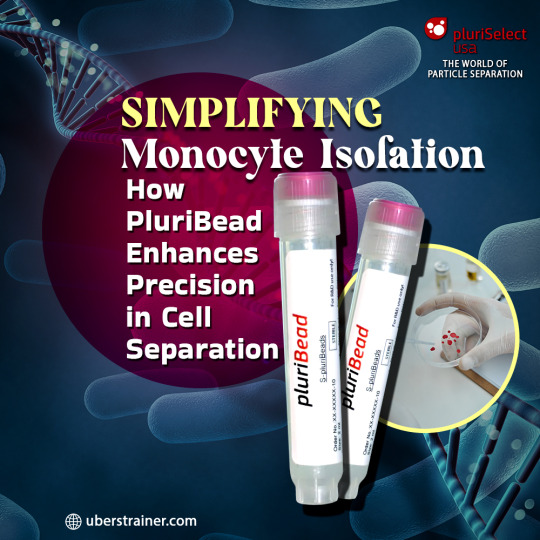
Efficient cell separation is crucial for isolating specific cell types like monocytes, especially in research and clinical applications. Traditional methods often involve multiple steps, expensive equipment, or risk damaging fragile cells. PluriBead revolutionizes this process by offering a magnetic-free, straightforward, and gentle approach to isolating target cells. This article explores how PluriBead simplifies monocyte isolation while enhancing precision in particle separation techniques.
What Is PluriBead Technology?
PluriBead is an innovative cell separation tool designed to isolate target cells without the need for complex equipment or extensive sample preparation. It uses antibody-coated beads to capture specific cells, which are then separated through a simple sieving process using a strainer cascade. The unwanted cells pass through the sieve, while the desired cells remain attached to the pluriBeads for further detachment and collection.
Key Advantages:
No Sample Preparation: PluriBead eliminates the need for gradient centrifugation or erythrolysis.
Versatility: It can process various sample materials, including whole blood, buffy coat, and tissue homogenates.
Rapid Results: Isolation can begin in as little as 5 minutes.
Gentle Process: Ensures high viability and yield, reducing the risk of damaging cells.
How Does PluriBead Work?
Step 1: Mixing
PluriBeads, coated with target-specific antibodies, are added to the sample material. This mixture is gently incubated, allowing the target cells to bind to the beads.
Step 2: Separation Using a Strainer Cascade
The mixture is passed through a pluriStrainer cell sieve. While the unwanted cells run through, the bead-bound target cells remain on top. This process is efficient and leverages particle filtration to achieve high precision.
Step 3: Detachment
Target cells are detached from the beads using a detachment buffer. The detached cells are then washed into a fresh collection tube, leaving the beads behind.
Specialized Features of PluriBead
Cell Enrichment: PluriBead isolates cells with high purity, ensuring that only the desired cell types are collected.
Parallel Cell Isolation: With the pluriBead cascade, researchers can separate two distinct cell types from a single sample.
Sequential Isolation: Up to six different cell targets can be separated sequentially from one sample, making it a versatile solution for complex research needs.
Multiple Applications: Beyond cell isolation, PluriBead can be used for viruses, bacteria, proteins, and RNA/DNA enrichment.
Choosing the Right PluriBead Size
PluriBead is available in two bead sizes:
S-PluriBead: Ideal for isolating small numbers of target cells from large volumes, such as circulating tumor cells (CTCs).
M-PluriBead: Suited for larger target cell populations in smaller sample volumes, such as buffy coat preparations.
Why PluriBead Excels in Particle Separation Techniques
PluriBead’s design eliminates the need for centrifugation and magnetic equipment, making it highly accessible for labs with limited resources. Its reliance on a simple particle filtration mechanism ensures accuracy and reproducibility while maintaining the integrity of fragile cells.
Conclusion
PluriBead’s straightforward workflow, versatility, and ability to achieve high-purity results make it a game-changer in cell separation. Whether isolating monocytes from whole blood or enriching specific cell types for advanced studies, PluriBead delivers precision and efficiency.
In conclusion, cell separation using PluriBead is a cost-effective, reliable, and user-friendly method for researchers and businesses seeking high-quality cell enrichment. Its flexibility across applications and species makes it a valuable tool for advancing cell-based research and therapeutic development.
0 notes
Text
Why Labs Are Choosing PluriMate: Key Benefits of Non-Disruptive Cell Separation

Laboratories aiming to separate leukocytes and peripheral blood mononuclear cells (PBMCs) with minimal contamination are increasingly turning to tools that leverage the density gradient centrifugation principle. Among these, PluriMate stands out due to its innovative design that simplifies cell separation while maintaining sample purity. PluriMate's unique sponge barrier enhances efficiency, making it a preferred choice for labs conducting regular cell isolation from whole blood or bone marrow.
1. Simplified Sample Preparation Process
One of the key benefits of PluriMate is its ease of use. Traditional cell separation methods often involve careful and time-consuming layering of blood over the separation medium, which requires skill and can increase the risk of cross-contamination. PluriMate eliminates this need entirely. Researchers can pour anticoagulated blood or bone marrow directly into the PluriMate tube without worrying about manual layering. This not only saves valuable time but also reduces the potential for errors, making it an ideal tool for labs looking to streamline their processes.
2. Innovative Particle Separation Techniques
PluriMate utilizes a built-in porous sponge made from high-grade polyurethane that acts as a non-disruptive barrier, facilitating reliable particle separation techniques. During centrifugation, this barrier prevents unwanted cells—like erythrocytes and granulocytes—from mixing with the desired cell population. The density gradient within the PluriMate tube separates leucocytes, lymphocytes, and PBMCs based on their specific densities, allowing them to collect in an interphase above the separation medium. This layer of targeted cells can then be easily harvested without contamination from denser, undesired cells. PluriMate’s particle separation techniques ensure that researchers receive high-quality samples for downstream applications.
3. Reduced Risk of Contamination
Contamination is a significant concern during cell separation, especially in multi-step processes where each step increases exposure to contaminants. PluriMate addresses this with its non-disruptive design that minimizes the need for handling. Once centrifugation is complete, the sponge barrier remains intact, preventing recontamination of the enriched cell fraction as it is harvested. This design is particularly beneficial when processing large batches or working with valuable samples, as it ensures that the isolated cells remain pure and ready for analysis or further applications, such as cell enrichment studies or cell-based assays.
4. Efficient Particle Filtration
Effective particle filtration is essential for isolating high-quality cell populations. PluriMate’s porous sponge acts as a built-in filter, preventing the mixture of the sample material with the separation medium, thereby preserving the integrity of the cells that need to be isolated. By keeping unwanted particles and cells out of the desired layer, PluriMate provides a reliable way to filter and enrich the sample without additional equipment. This feature makes it particularly attractive for labs seeking straightforward solutions for cell separation and filtration, with minimal need for extra tools or manual intervention.
5. Versatile for Various Applications
PluriMate is adaptable to both large and small sample volumes, making it a versatile tool in laboratories with diverse sample processing needs. Whether pre-filled with the separation medium or provided as an unfilled tube, PluriMate offers flexibility for a wide range of cell separation protocols. Additionally, it can be combined with pluriSpin for negative cell separation, further expanding its utility. This versatility allows researchers to conduct multiple applications, including cell enrichment and density-based separations, making it an invaluable addition to modern labs.
Conclusion
For labs prioritizing efficiency, reduced contamination, and reliable separation, PluriMate is an effective solution that operates on the density gradient centrifugation principle. With its innovative sponge barrier, easy handling, and adaptability to various cell separation tasks, PluriMate meets the demands of researchers focused on high-quality results. By simplifying the cell separation process, PluriMate enables laboratories to achieve consistent outcomes while maintaining sample purity, making it a top choice for professionals in the field of particle separation and cell isolation.
0 notes
Text
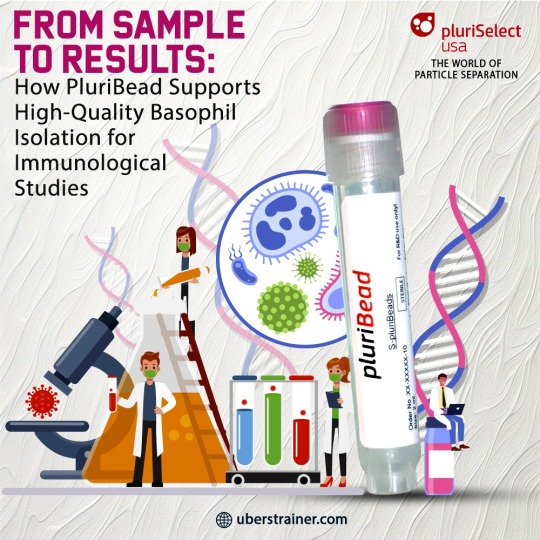
From Sample to Results: How PluriBead Supports High-Quality Basophil Isolation for Immunological Studies
PluriBead provides a streamlined, non-magnetic solution for efficient basophil isolation, simplifying the process and enhancing sample quality through advanced antibody cell separation techniques.
When it comes to high-quality cell isolation, the right technology can make all the difference. For researchers focused on basophil isolation and related immunological studies, PluriBead offers a cutting-edge solution that simplifies and enhances the process. This blog will explore how PluriBead supports efficient basophil isolation using advanced antibody cell separation techniques, delivering reliable results for your research needs.
What Makes PluriBead Stand Out?
PluriBead is a unique cell separation technology that distinguishes itself by working without magnetic components. This non-magnetic approach is designed to streamline the process, making it simpler and more efficient. Unlike traditional methods that require complex procedures or additional equipment, PluriBead offers a straightforward solution: sieve the PluriBeads with bound target cells through a lab cell strainer. The beads with your target cells remain on top, while unwanted cells pass through. After a simple detachment step, your target cells are ready for further analysis.
Key Features of PluriBead for Basophil Isolation
No Sample Preparation Required: One of the main advantages of PluriBead is its simplicity. You can use samples ranging from 200 µl to 45 ml without the need for gradient centrifugation, erythrolysis, or other pre-treatments. This saves time and reduces the complexity of your workflow.
Versatile Sample Materials: PluriBead can handle a wide range of sample types, including whole blood, buffy coat, PBMCs, and various tissues like brain homogenates, spleen, and liver. This versatility ensures that you can adapt the technology to your specific research needs.
High Range of Species: Whether you're working with human, mouse, rat, bovine, canine, or sheep samples, PluriBead accommodates various species. This broad application range is beneficial for comparative studies and cross-species research.
Fast and Gentle Isolation: PluriBead supports fast isolation starting from just 5 minutes. Its gentle approach ensures a high yield of viable cells, minimizing sample requirements and preserving the integrity of your basophils.
Universal Beads for Any Antibody: The PluriBead technology is compatible with any external antibody, providing flexibility in selecting the most suitable markers for your research.
Simultaneous and Sequential Cell Isolation: With PluriBead Cascade straining, you can separate two different cell types simultaneously from a single sample. Additionally, sequential isolation allows you to target up to six different cells from one sample, enhancing your research efficiency.
How PluriBead Enhances Basophil Isolation
Basophils play a critical role in immune responses and are often challenging to isolate due to their low abundance and delicate nature. PluriBead’s non-magnetic cell separation technology is particularly advantageous for isolating these cells. By leveraging PluriBead, researchers can achieve high-purity basophil samples without the complications associated with magnetic bead-based methods.
1. Simple and Effective Workflow: The PluriBead process is streamlined. Start by labeling your sample with the appropriate antibody. Next, incubate the sample to allow binding of the target basophils to the beads. During isolation, the beads with the bound basophils are retained, while the non-target cells are removed. Washing and detaching the basophils from the beads completes the process, providing a ready-to-use sample for downstream applications.
2. Enhanced Sensitivity and Specificity: By avoiding the need for complex pre-treatments and using a non-magnetic approach, PluriBead minimizes potential sources of error and maximizes sensitivity. This ensures that you obtain high-quality basophil isolates, which is crucial for accurate immunological studies.
3. Flexible Applications: PluriBead’s ability to handle various sample types and its compatibility with different antibodies make it a versatile tool for a wide range of applications. Whether you are studying basophils in blood samples or tissue homogenates, PluriBead adapts to your needs.
Conclusion
For researchers and labs focused on basophil isolation and immunological studies, PluriBead offers a robust and efficient solution. Its non-magnetic cell separation technology simplifies the workflow, providing high-quality basophil samples without the need for extensive sample preparation. By incorporating PluriBead into your research, you can leverage advanced antibody cell separation techniques and cell separation technology to enhance your studies and achieve reliable results.
Explore how PluriBead can transform your cell isolation processes and support your research endeavors today.
#antibody cell separation#cell separation technology#particle separation techniques#particle filtration#40 um cell strainer#cell enrichment techniques#medical#uberstrainer
0 notes
Text
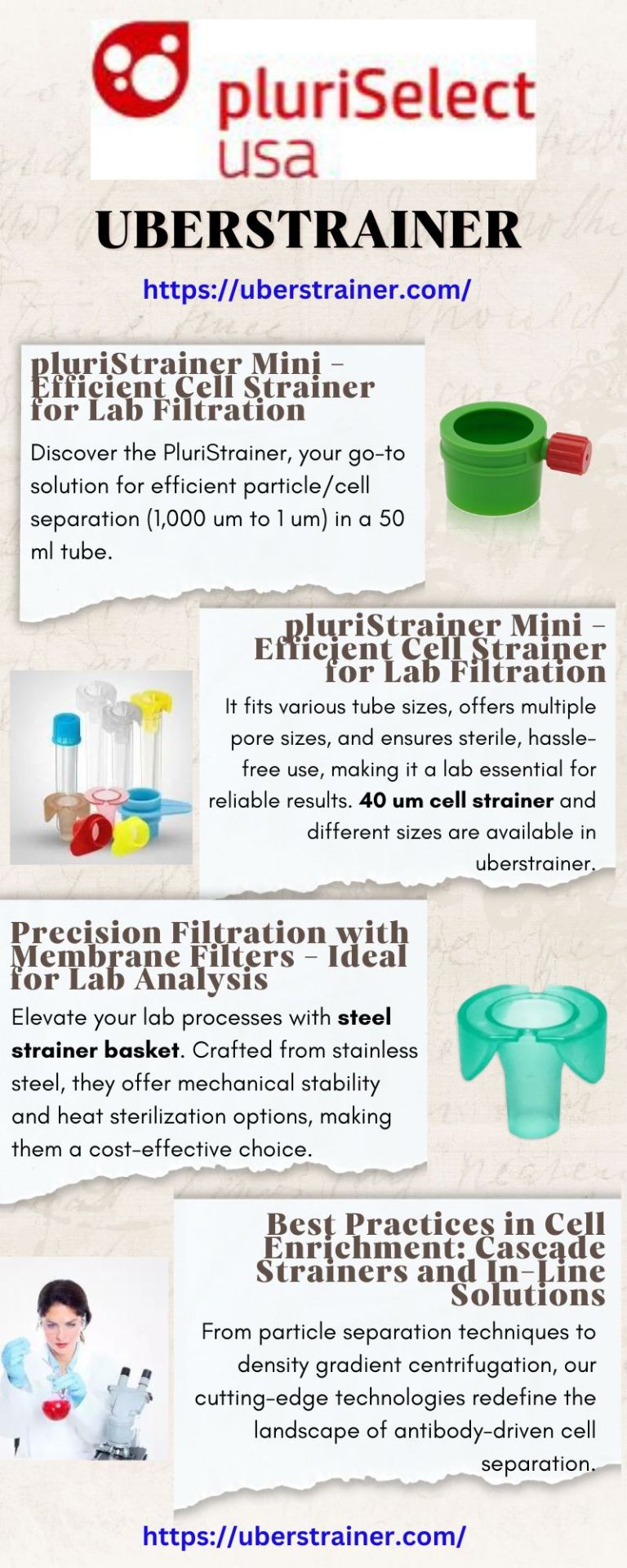
Achieve Precision Filtration: Shop Cascade Strainers at Uberstrainer
Achieve precise particle separation with strainer cascade from Uberstrainer. Explore our range of high-quality filtration solutions.
visit us :- https://uberstrainer.com/
#antibody cell separation#uberstrainer#cell separation technology#particle filtration#particle separation techniques#40 um cell strainer#cell enrichment techniques
0 notes
Text

Maximizing Efficiency with ÜberStrainer: Tips for Better Cell Separation and Filtration
In laboratory research, optimizing cell separation and filtration is key to achieving precise and high-quality results. When it comes to selecting the best lab cell strainers, ÜberStrainer stands out as a top choice. Designed to enhance your workflow and deliver reliable outcomes, ÜberStrainer offers a range of features that make it an essential tool for researchers and labs focused on precision and efficiency.
VCISIT US :- https://uberstrainer.com/
#uberstrainer#antibody cell separation#cell separation technology#particle filtration#particle separation techniques#40 um cell strainer#cell enrichment techniques
0 notes
Text

From Whole Blood to Purified Cells: Mastering Cell Separation with PluriMate and TwinSpin
PluriMate and TwinSpin streamline the cell separation process by utilizing the density gradient centrifugation principle to efficiently isolate high-quality cells for research.
visit us :- https://uberstrainer.com/
#antibody cell separation#cell separation technology#particle separation techniques#particle filtration#40 um cell strainer#cell enrichment techniques#uberstrainer#cellsepration
0 notes
Text
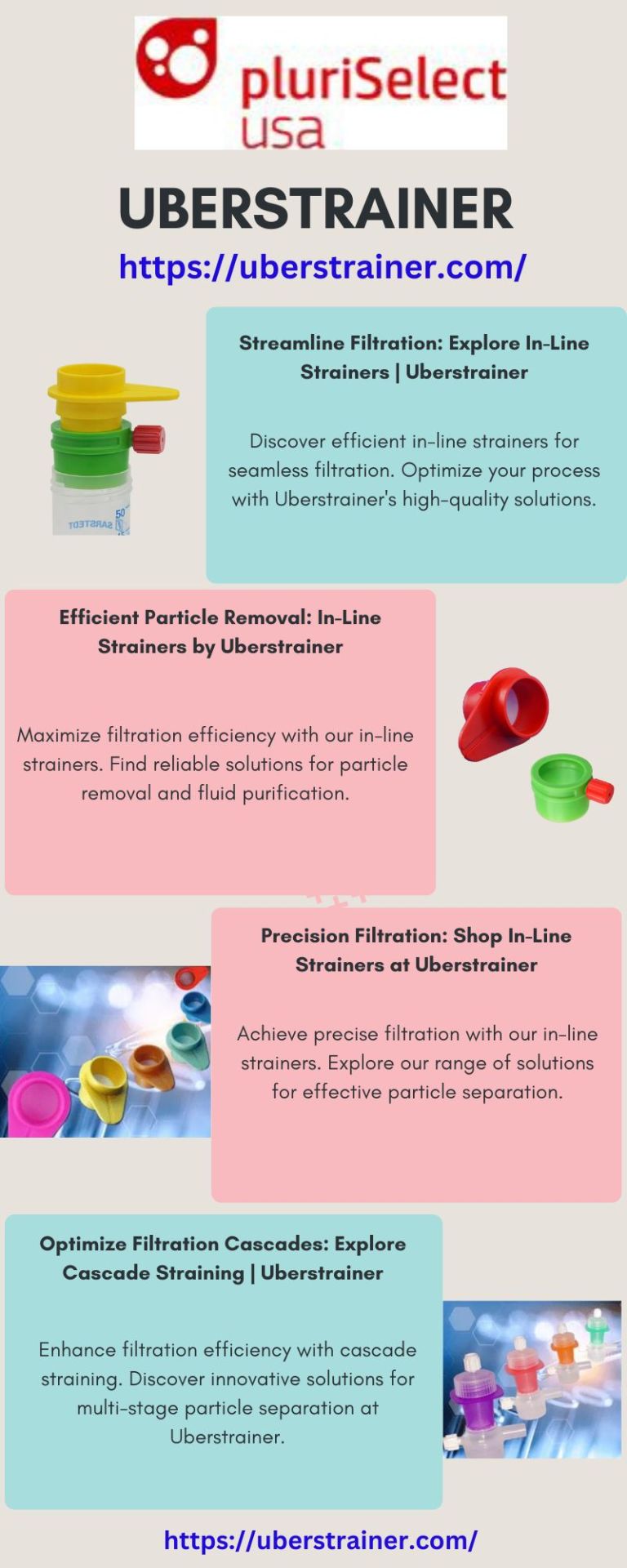
Precision Filtration: Shop In-Line Strainers at Uberstrainer
Achieve precise filtration with our in-line strainers. Explore our range of solutions for effective particle separation.
#antibody cell separation#cell separation technology#particle separation techniques#particle filtration#40 um cell strainer#cell enrichment techniques#uberstrainer
0 notes
Text
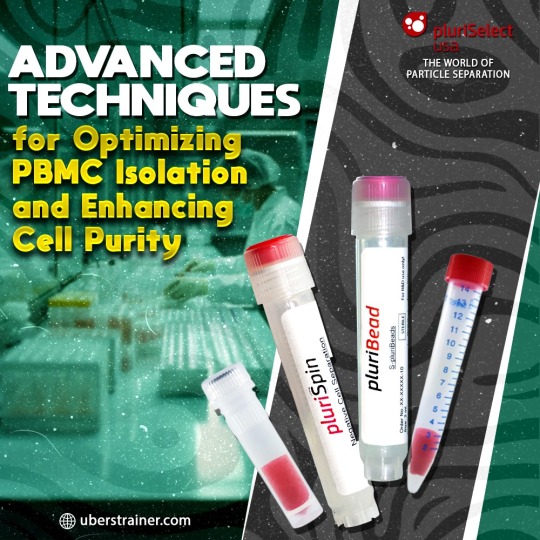
Advanced Techniques for Optimizing PBMC Isolation and Enhancing Cell Purity
Due to their significant role in immune response, PBMCs are widely used in research and clinical applications. Isolating PBMCs efficiently and effectively is crucial, and advanced techniques like density gradient centrifugation principle play a pivotal role in this process.
#uberstrainer#antibody cell separation#particle separation techniques#particle filtration#cell separation technology#40 um cell strainer#cell enrichment techniques
0 notes
Text
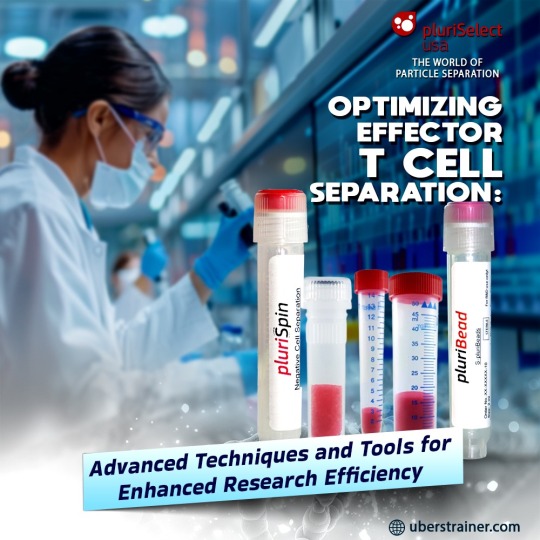
Optimizing Effector T Cell Separation: Advanced Techniques and Tools for Enhanced Research Efficiency
The article explores the importance of effector T cell separation, detailing various T cell types and discusses advanced cell separation products like pluriSpin and pluriBead to enhance research efficiency in labs.
Effector T cells are critical components of the immune system, actively responding to various stimuli such as co-stimulation. These cells include several types of T cells, such as CD4+, CD8+, and regulatory T (Treg) cells, each playing a distinct role in maintaining immune homeostasis and combating infections and diseases. For researchers and laboratories, the ability to isolate these cells efficiently and effectively is vital for studying immune responses, developing therapies, and conducting clinical research.
To achieve optimal Antibody Cell Separation, advanced cell separation technology is essential. This article delves into the specifics of effector T cell types, the importance of isolating these cells, and how innovative products like pluriSpin and pluriBead enhance the efficiency and effectiveness of this process.
Types of Effector T Cells and Their Roles
Effector T cells encompass a variety of T cell types, each with a specific function within the immune response. Understanding these roles is crucial for researchers who need to isolate these cells for various applications.
1. Regulatory T Cells (Treg Cells)
Regulatory T cells, or Treg cells, are essential for maintaining immune tolerance and preventing autoimmunity. Their primary role is to suppress the immune response after it has successfully neutralized a pathogen, ensuring that the immune system does not overreact. Treg cells also play a crucial role in suppressing auto-reactive T cells that may have escaped the thymus during negative selection. Efficient isolation of Treg cells is crucial for studying autoimmune diseases, transplantation tolerance, and immunotherapy.
2. Helper T Cells (Th Cells)
Helper T cells, or Th cells, assist other leukocytes in immunological processes. They are pivotal in the maturation of B cells into plasma cells and memory B cells, which are crucial for the body's long-term immune response. Isolating pure Th cells allows researchers to better understand their role in various immunological processes and in developing vaccines and immune therapies.
3. Cytotoxic T Cells (Tc Cells)
Cytotoxic T cells, also known as killer T cells, are responsible for destroying virus-infected cells and tumor cells. They are also involved in transplant rejection. The ability to isolate these cells with high purity is vital for research focused on cancer immunotherapy, viral infections, and transplant immunology.
The Importance of Advanced Cell Separation Technology
Isolating effector T cells from complex sample materials like whole blood, buffy coat, and cord blood requires precision and efficiency. Traditional methods, while foundational, often fall short in delivering the purity and yield required for advanced research. This is where advanced cell separation technology comes into play, offering researchers the tools they need to obtain high-quality, viable cells with minimal manipulation.
The following sections will explore how pluriSpin and pluriBead technologies facilitate the efficient isolation of effector T cells, highlighting their benefits and applications.
pluriSpin: Negative Cell Isolation for Untouched Cells
The pluriSpin system is designed for the negative isolation of untouched and highly purified cells directly from whole blood, buffy coat, or cord blood. Negative isolation is a technique where unwanted cells are labeled and removed, leaving the target cells untouched and ready for downstream applications.
pluriBead: A Novel Approach to Cell Isolation
pluriBead technology offers a unique approach to cell separation that does not rely on magnetic components. Instead, it uses a physical separation method that is simple, efficient, and effective for a wide range of applications. pluriBead is available in specific formulations for the positive isolation of CD4+ and CD8+ T cells from both human and murine samples. This flexibility allows researchers to tailor their cell isolation procedures to their specific experimental needs.
Conclusion: Enhancing Research with Advanced Cell Separation Technology
For researchers and laboratories, the ability to efficiently and effectively isolate effector T cells is crucial for advancing our understanding of immune responses, developing new therapies, and conducting cutting-edge research. Advanced cell separation technology, such as pluriSpin and pluriBead, offers innovative solutions that enhance the purity, viability, and functionality of isolated cells.
These technologies are designed to meet the needs of modern research, providing tools that simplify the cell isolation process while delivering high-quality results. By incorporating pluriSpin and pluriBead into their workflows, researchers can focus on their experiments with confidence, knowing that they are working with the best cell separation techniques available. Whether you're studying the role of regulatory T cells in autoimmune diseases, investigating helper T cell function in vaccine development, or exploring cytotoxic T cells in cancer immunotherapy, these advanced cell separation products will support your research goals by providing reliable, efficient, and effective cell isolation solutions.
#uberstrainer#antibody cell separation#particle separation techniques#cell separation technology#particle filtration#40 um cell strainer#cell enrichment techniques
0 notes